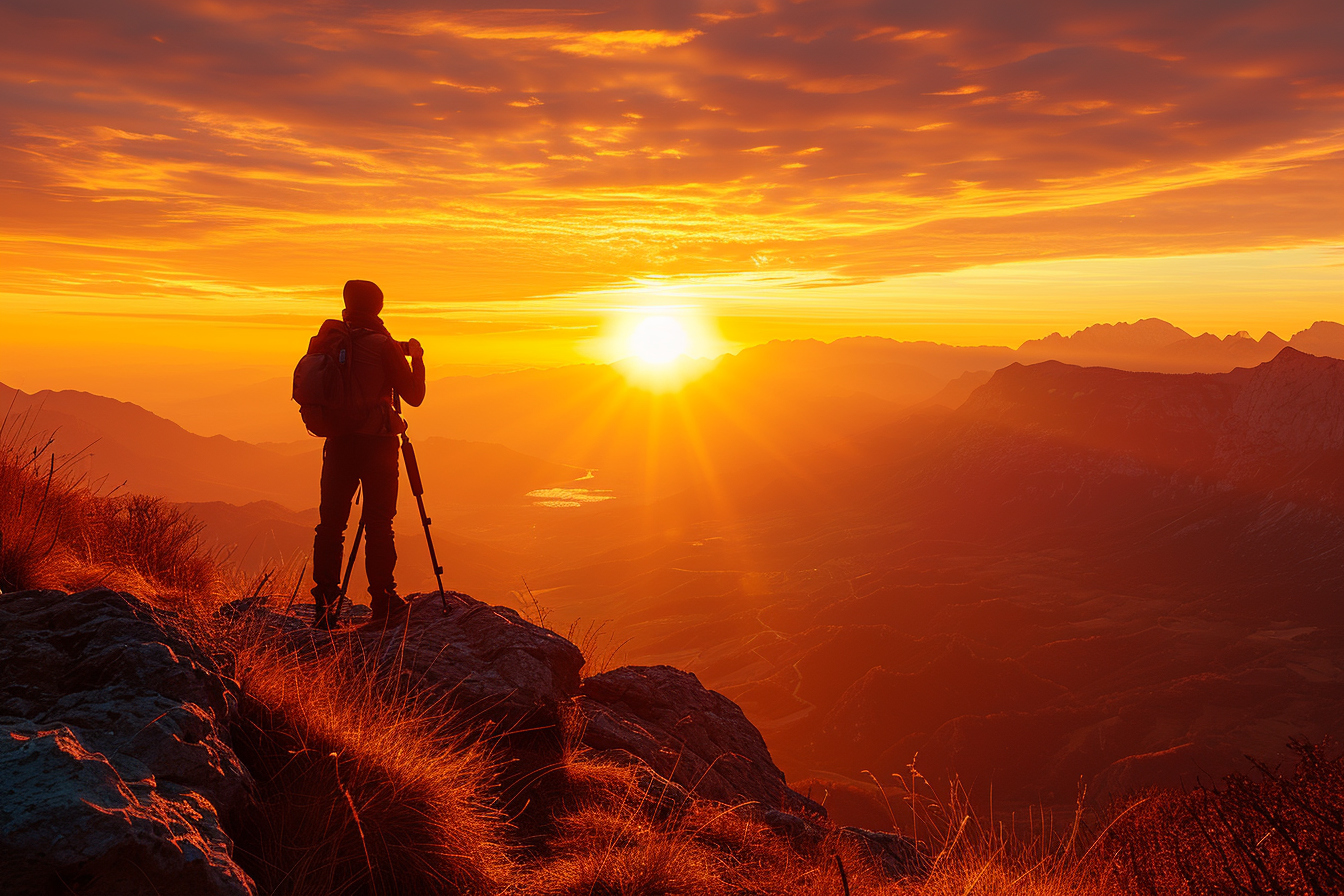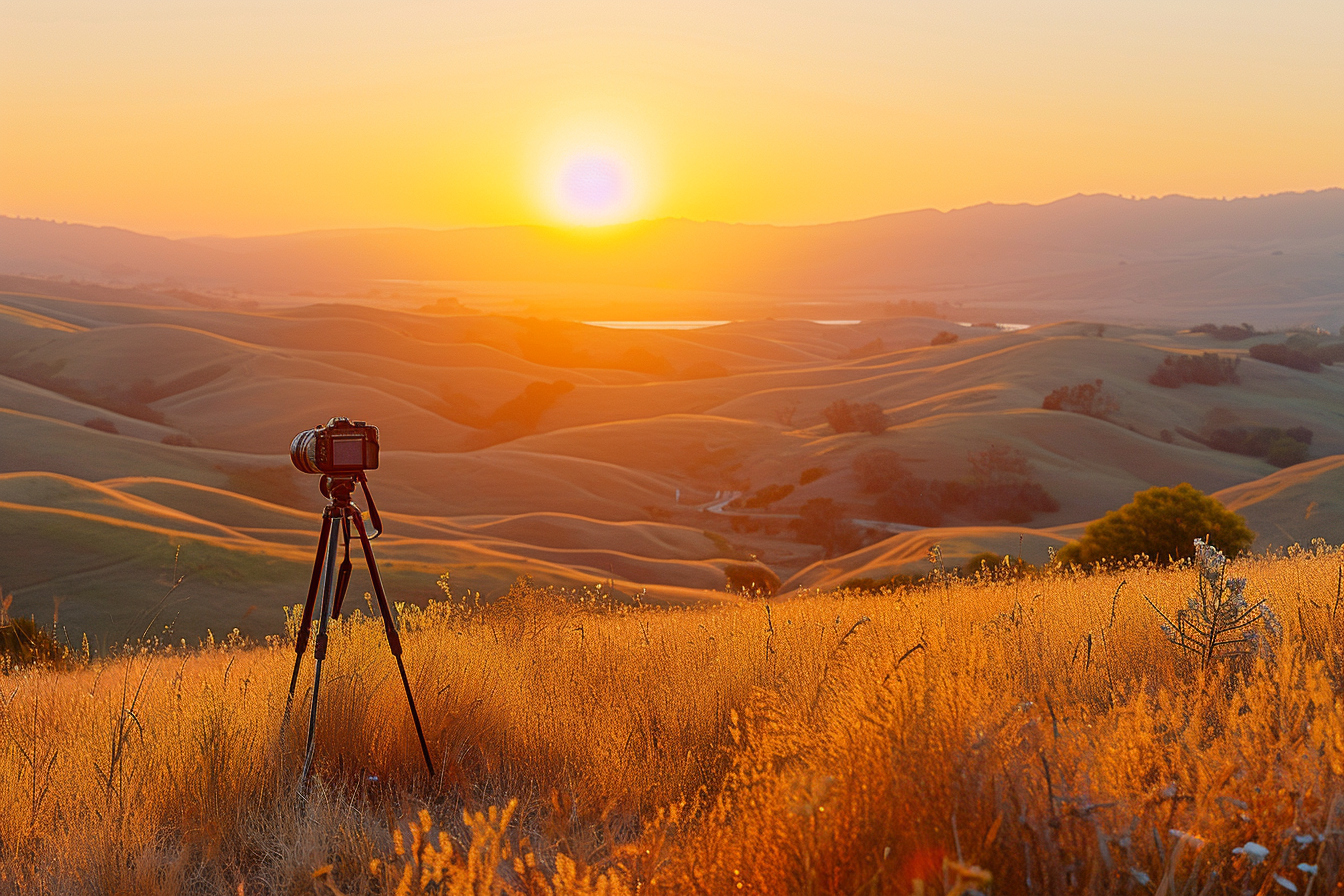The ethereal glow of sunrise offers a unique challenge and opportunity for landscape photographers. This mystical time of day, when light and color dance across the sky, is a perfect canvas for crafting images that evoke emotion and wonder. In the delicate balance between night and day, photographers find a palette of colors and moods unavailable at any other time, creating the potential for truly captivating images.
Understanding the golden hour
What is the Golden Hour? It’s a term photographers use to describe the period shortly after sunrise (or before sunset) when the light is softer and warmer in tone. During this period, the sun’s low angle in the sky produces a diffused light that minimizes harsh shadows and bathes the landscape in a flattering glow.
The quality of sunshine light:
- Softness: The light is more diffuse, reducing contrast and allowing for a balanced exposure of both the landscape and the sky.
- Direction: With the sun low on the horizon, long shadows add depth and texture to the landscape.
- Color: Hues during sunrise tend to be softer and more subtle compared to sunset, with delicate pastel tones that can add a serene mood to the scene.
Planning your sunrise shoot

Researching the location
Scout your chosen location in advance, ideally at different times and weather conditions. Familiarity with the terrain enables the photographer to anticipate compositional opportunities and challenges. Employing tools such as Google Earth or specialized photography apps that provide sun position and light behavior can greatly aid in planning.
Weather watching
Closely monitor weather forecasts. Clear skies can be beautiful, but a few clouds can add drama and depth to a sunrise landscape. However, an overcast sky might not produce the desired effects, so constant vigilance is key to intercepting the perfect conditions.
Gear preparation
The right equipment, properly prepared, is crucial. Pack a sturdy tripod to stabilize the camera during the low light conditions of early dawn. Consider a wide-angle lens to capture the grandeur of vast landscapes, and perhaps a telephoto lens to isolate interesting details. Also, remember to bring extra batteries and memory cards, as cold morning temperatures can drain battery life quickly.
Compositional mastery
The rule of thirds
The Rule of Thirds is a powerful compositional technique in photography. Imagine splitting the frame into nine equal parts by two equally spaced horizontal lines and two equally spaced vertical lines. Placing points of interest at the intersections or along these lines creates more tension, energy, and interest compared to a centrally placed subject.
Foreground interest
Introducing elements in the foreground gives an image depth and leads the viewer’s eye into the scene. Whether it’s rocks, vegetation, or water, these elements should add to the story you’re trying to tell without overshadowing the broader landscape.
Leading lines and shapes
Use natural or man-made lines, such as paths, rivers, or the shapes of hills, to draw the viewer’s eye through the photograph. These leading lines should ideally guide towards the focal point of your composition, be it a rising sun or a dramatic part of the skyline.
Technical proficiency
Setting the camera
While automatic settings can provide decent results, manual control allows for precision:
- ISO: Keep it low (100-200) to reduce noise.
- Aperture: A mid-range aperture (f/8-f/16) provides adequate depth of field without diffraction softening the image.
- Shutter Speed: Adjust based on lighting conditions and the presence of any moving elements such as water or clouds.
Using filters
Neutral Density (ND) filters can balance the exposure between the sky and the landscape. Graduated ND filters are particularly useful at sunrise, when the brightness of the sky can vastly differ from the foreground.
Focus techniques
Focusing is paramount in landscape photography. Use manual focus to ensure sharpness where it counts or the camera’s autofocus points to select a specific area of the image. A technique known as focus stacking, where multiple images at different focus points are blended in post-processing, can ensure front-to-back sharpness.
Exposure bracketing
The technique of taking multiple shots of the same scene at different exposures can be invaluable at sunrise. This practice, known as exposure bracketing, provides the material to create a High Dynamic Range (HDR) image in post-processing, ensuring that both the darkest shadows and the brightest highlights are well exposed.
Capturing the magic
Embrace the colors
Sunrise offers a spectrum of colors that change rapidly. Begin shooting before the sun crests the horizon to capture the soft blues and purples of the twilight, and continue as the colors transition into the warm yellows and oranges of the actual sunrise.
Silhouettes and shapes
As the sun rises, it can backlight subjects, creating striking silhouettes. Positioning yourself so that trees, buildings, or mountains are in front of the rising sun can yield bold graphical shapes and contrasts within the landscape.
The importance of patience
Capturing the perfect sunrise shot requires patience. The lighting can change dramatically in a matter of minutes, and what may initially seem a lackluster dawn could suddenly transform into a fiery spectacle. Arriving early and staying late ensures that you won’t miss these transitory moments.
Post-Processing techniques

Raw power
Shoot in RAW format to capture as much detail as possible, providing greater flexibility for adjustments in post-processing software such as Adobe Lightroom or Photoshop. This is particularly important for sunrise photos, where you may need to recover details in both highlights and shadows.
Balancing act
Adjust the white balance to reflect the true colors of the sunrise, or to creatively enhance the mood of the image. Tweaking the highlights, shadows, contrast and clarity can bring out the best in your sunrise landscape.
Creative edits
Consider the artistic use of gradients or radial filters to subtly bring focus to parts of the image or to further balance the exposure post-shoot. However, strive for subtlety to avoid an over-processed look which can detract from the natural beauty of a sunrise.
Ethical and environmental consideration
Respect the Land: As you seek the perfect sunrise photo, remember to tread lightly and leave no trace in the natural environment. Protecting these landscapes ensures their beauty endures for future generations and photographs.
Cultural Sensitivity: In some cultures, areas with spiritual or historical significance may have photography restrictions, or require permissions. Always respect local customs and regulations.
Conservation Efforts: Engage with local conservation initiatives and consider how your photography might raise awareness or support for these causes. Images have power, and with that power comes a responsibility to the subjects we capture.
Continuous learning
Analyze Other Works: Study the sunrise landscapes of renowned photographers. Analyze their compositions, lighting choices, and post-processing techniques to gain insights into their approaches and styles.
Experiment: Don’t be afraid to experiment with different settings, perspectives, and compositions. Every sunrise is unique, and with each one, there’s a new lesson to be learned.
Seek Feedback: Join photography communities, take part in workshops, or find a mentor to get constructive feedback on your work. Learning from others can accelerate your growth as a photographer.
Embracing the journey
Landscape photography at sunrise is an art that combines patience, planning, and technical prowess with the unpredictability of nature. It is this mix of certainty and surprise that captures the hearts of photographers who rise before the light. With each dawn, there is a story to tell, an emotion to capture, and a landscape to preserve within a frame.
The mastery in this field is not just in the creation of the image, but in the journey that leads up to that decisive moment when the shutter closes. So wake with the birds, set up in the silence of pre-dawn, and watch as the world awakens in a blaze of color and light. Your best sunrise landscape photograph is not just a picture; it’s an experience, an interaction with the world at its most serene and its most dramatic. And there, on the edge of daybreak, you’ll find the artistry that keeps us coming back for that perfect shot.